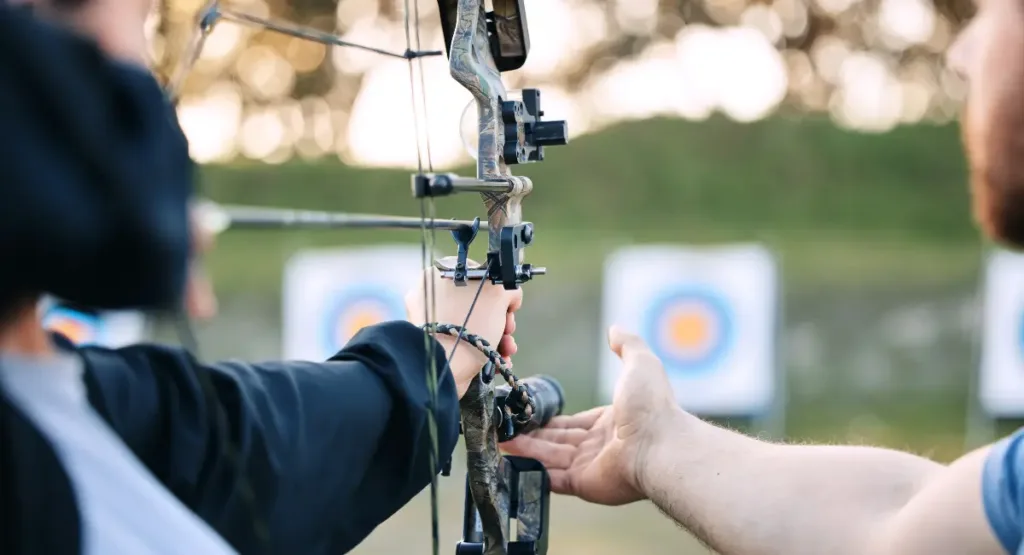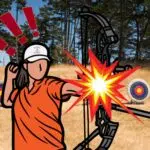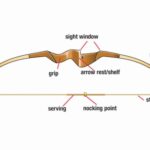Introduction
Welcome to the Ultimate Bow Size Chart Guide for Archers! You’re not alone if you’ve ever wondered which bow size to choose. The right bow size is pivotal for archery’s precision, comfort, and safety.
This comprehensive guide aims to demystify the bow size chart so that you can make informed decisions tailored to your archery needs. Whether you are just starting your archery journey or looking to refine your equipment choices, the first step in improving your archery skills is to understand the intricacies of the bow size chart.
Understanding Bow Sizes
The Basics of Bow Sizing
An understanding of bow sizing is crucial to picking the perfect bow. Unlike clothing based solely on one dimension, bow sizing involves considering draw length, weight, and the archer’s physical characteristics. These factors can be matched to the ideal bow dimensions using the bow size chart, ensuring that performance is enhanced and injury risks are minimized.
Why Bow Size Matters
A correctly sized bow acts as an extension of the archer, facilitating a seamless flow of energy from the archer to the arrow. Having a proper fit enhances accuracy and ensures the archery experience is enjoyable and comfortable. We understand the importance of consulting the bow size chart before selecting your bow since it directly impacts your shooting technique and overall success as a sportsperson.
Measuring for Your Perfect Bow
Finding Your Draw Length
Determining your draw length is the cornerstone of effectively using the bow size chart. This measurement reflects the distance from the bow’s nock point to the pivot point on the bow grip plus 1 ¾ inches. You can ascertain your draw length by stretching your arms parallel to the floor, measuring the span from fingertip to fingertip, and then dividing that number by 2.5. This simple calculation gives you a starting point to navigate the bow size chart confidently.
Bow Size Chart Explained
When you know your draw length, you’re ready to look over the bow size chart. This chart correlates draw length with recommended bow sizes, providing archers with a clear guideline for finding their perfect bow. The chart can serve as a good starting point, but it is essential to remember that personal preferences and shooting styles also play a crucial role in deciding what to buy.

Types of Bows and Size Considerations
Recurve vs. Compound Bows
Each recurves, and the compound bow has unique characteristics that influence its ideal size for bow sizing. The bow size chart focuses on the relationship between draw length and bow length for recurve archers to ensure that the archer can manage the bow’s draw weight comfortably. Conversely, compound bow users have the advantage of adjustable draw lengths, allowing for more flexibility in sizing. To make a sound purchase, it is crucial to consult the bow size chart regardless of the type of bow.
Adjusting Bow Size for Children and Teens
In youth archery, sizing is another important consideration, as children and teenagers are still growing, which means that their ideal bow sizing will change over time as they grow. To accommodate youth archers’ growing stature and strength, the bow size chart will often include lower draw weights and shorter draw lengths. To ensure that young archers have equipment suitable for their skill development, it is essential to refer to the bow size chart regularly as they grow.
Common Mistakes to Avoid
There are a few common mistakes to remember when navigating the bow size chart, and one such mistake is choosing a bow solely based on draw weight rather than taking into account the bow’s draw length. The result can either be a bow that is difficult to pull or a bow that doesn’t offer enough resistance for proper form development because of this oversight. Another mistake is neglecting personal comfort and shooting style, which are just as important as the numerical guidelines provided by the bow size chart when it comes to bow size. It is essential to avoid these mistakes so that the archer and bow can be matched in a better way.
Frequently Asked Questions
Q: Can I use the same bow size chart for recurve and compound bows?
A: While the fundamental concepts behind the bow size chart apply to recurve and compound bows, each type has specific considerations. It’s crucial to consult a chart designed for your bow type to ensure accuracy.
Q: What if my measurements fall between sizes on the bow size chart?
A: Consider your experience level and personal preference if your measurements fall between sizes. Beginners may benefit from the smaller size for easier control, while more experienced archers prefer the next size up for increased power.
Q: How often should I reassess my bow size?
A: It’s wise to reassess your bow size if you experience significant changes in your physical condition or skill level or if you’re transitioning to a different style of archery. Youth archers should check their sizes more frequently due to growth spurts.
Q: Does the bow size chart change for left-handed archers?
A: The bow size chart applies universally to both left- and right-handed archers. The primary considerations of draw length and weight remain the same, regardless of hand dominance.
Conclusion
When it comes to archery, selecting the right equipment is essential; the bow size chart is an invaluable tool in this regard. Using the principles outlined in this guide, archers can ensure that their bow will enhance their performance, comfort, and enjoyment of the sport by selecting a bow that will improve their performance, comfort, and joy.
Remember that the perfect bow is more than just measurements and numbers; it is about finding a bow that feels like an extension of your body. May your arrows always find their mark, and may you have a happy and successful shooting season!
Recent Posts
- The Ultimate Guide to Compound Bows 2024: History, Maintenance, and Performance
- Mastering Archery: A Step-by-Step Guide on How to Use, Aim, and Draw a Bow
- 5 Basic Steps To Tune A Bow With Advanced Techniques
- Understanding Dry Firing a Bow: What It Is, Why It’s Bad, and How to Prevent It
- 7 Essential Parts of a Bow: A Comprehensive Guide for Archery Enthusiasts
- How to Measure Draw Length of a Bow: A Comprehensive Guide for Archers







